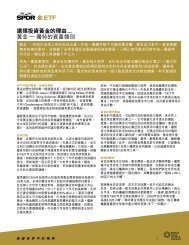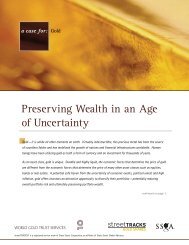Create successful ePaper yourself
Turn your PDF publications into a flip-book with our unique Google optimized e-Paper software.
The role of gold in reducing extreme lossesfor Western investorsIntuitively, the characteristics that gold exhibits in terms of itsperformance, volatility and correlation to other assets discussedin section I, should also help reduce potential losses in aportfolio, but is this the case in practice?To answer this question, we looked back at periods of financialstress and analysed a collection of assets representative oftypical investment portfolios for US dollar, pound-sterling, andeuro-based investors. 11 These include cash, government andcorporate bonds, international debt from developed markets,domestic and international equities, and commodities aswell as gold as separate asset class. 12 The portfolios underconsideration had a benchmark 60/40 moderate compositionwith 5% allocated to cash, 35% to bonds, 50% to equities,5% to commodities, and 5% to gold. When gold was notincluded, other assets were re-weighted proportionally. Weanalysed periods going back to 1987, 13 when financial marketsexperienced an unexpected and negative shock that affectedmore than one asset class.The eight events under consideration included:1 The market crash around October 1987, also known as“Black Monday”;2 The 1998 Long-term Capital Management (LTCM) crisis;3 The Dot-com bubble burst in the period surrounding thedramatic drop in the NASDAQ index between March 2000and April 2001;4 The 9/11 terrorist attacks in 2001;5 The 2002 market downturn;6 The financial crisis of 2007-2009, also referred to as theGreat Recession;7 The first phase of the European sovereign-debt crisisbetween April and July 2010; and8 The second phase of the European sovereign-debt betweenFebruary and October 2011.Our analysis shows that portfolios including gold tended toperform better in most cases (either by boosting gains orreducing losses) than those without (Chart 5). We found that,by adding a 5% allocation to gold, European and UK investorswould have reduced their losses during all tail-risk events underconsideration, while US investors would have saved capitalin all events except for the Dot-com bubble burst. A possibleexplanation is that the Dot-com bubble sector concentrationreduced the market-wide impact and subsequently themove into gold. By holding gold during all tail events underconsideration, investors in the US, Europe and the UK wouldhave saved approximately 5.5% in total. This would havetranslated to savings of almost US$54,800 for every US$1mnin assets held in a portfolio. Equivalently, it would translate to€55,200 or £54,600 for every one million euro or pounds inholdings.Moreover, long-run average returns for the portfolios withand without gold were similar. In other words, average gainsremained consistent but extreme losses were, on mostoccasions, reduced. Thus, gold not only helps to manage riskfor expected or theoretical losses, but on multiple occasions itwas shown to reduce the observed loss of an investment whilekeeping a similar average return profile. 1411 This section summarises (and updates) some of the key findings in <strong>Gold</strong>: hedging against tail risk, October 2010, where details on methodology andadditional results can be found.12 See Table 2 in the Appendix for more details on representative indices/securities used for each asset class.13 Ideally, we would use series going back as far as 1972, the year by which the gold window had been closed and gold was allowed to float freely. However,a modern investor typically holds many more assets in a portfolio than those available in the 1970s and early 1980s, or for which data are unavailable orunreliable, such as high-yield bonds or emerging-markets sovereign debt and equities. Moreover, the period starting 1987 is sufficiently relevant as itcontains at least three business cycles and includes multiple market crashes < http://www.nber.org/cycles/cyclesmain.html.>14 A constraint of this analysis is that the portfolios used to show the properties of gold as a tail-risk hedge were constructed using information that may nothave been available to investors prior to the event’s occurrence. In other words, we are using an “in-sample” approach to compute returns, volatilitiesand expected losses. This does not invalidate the analysis, but it does raise the question of whether selecting a portfolio allocation using only informationavailable during a specific period of time will still deliver similar results (i.e., if adding gold to the portfolio mix allows investors to manage risk moreeffectively) for events that happen outside of that period. The answer is that it does. <strong>Gold</strong> can be shown to reduce losses even in out-of-sample analysisfor most cases. We estimated average correlations and volatilities using weekly returns between January 1987 and June 2007, excluding the mostrecent period. We found optimal portfolios using the same methodology as before: with and without gold. We selected the portfolio with the maximuminformation ratio, as well as a portfolio with allocations similar to a typical benchmark portfolio for a total of four portfolios.<strong>Gold</strong> <strong>Investor</strong> | Risk management and capital preservation










